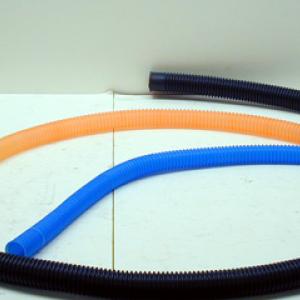College of Liberal Arts & Sciences
3D30.35 - Freq Tube
Grasp the tubes by one end and whirl in a circle over your head. The faster you whirl the tube the higher the frequency. Note that the sound does not go up steadily but goes up by specific intervals. Place the cork in one end of the tube and note that no sound is produced.
Some approximate values of our freq tubes.
| Orange Tube | Blue Tube | |
| Closed tube | 80 Hz. | 100 Hz. |
| Fundamental | 160 Hz. | 200 Hz. |
| 1st | 325 Hz. | 430 Hz. |
| 2nd | 485 Hz. | 630 Hz. |
| 3rd | 645 Hz. | 830 Hz. |
| 4th | 810 Hz. | 1030 Hz. |
| 5th | 980 Hz. | 1270 Hz. |
This variation from a Tap-L conversation by Andy Smith. Take a 5 gallon bucket with a hole drilled in the closed end just large enough for one end of the tube to attach. Fill a trash can up with water. Push the open end of the bucket down into the water. The tube will sing. Knowing the speed the bucket is pushed down into the water and the ratio of the tube and bucket areas, you can determine the speed the air travels through the tube. This works on the standard toy version and many other corrugated tubes.
- Lutz Kasper, Patrik Vogt, "Howling Winds and Swinging Sticks: An Acoustical Analysis", TPT, Vol. 60, #5, May 2022, p. 392.
- Michael J. Ruiz, "'The '2001' Theme on the Whistling Tube", TPT, Vol. 54, #5, May 2016, p. 310.
- Terry Toepker, "Beach 'Corrugabugle'", TPT, Vol. 49, #8, Nov. 2011, p. 467.
- Maria Eva Amorim, Teresa Delmira Sousa, P. Simeão Carvalho, and Adriano Sampaioe Sousa, "A Simple Experiment to Explore Standing Waves in a Flexible Corrugated Sound Tube", TPT, Vol. 49, #6, Sept. 2011, p. 360.
- Louis H. Cadwell, "Singing Corrugates Pipes, Using Video Cameras to Measure Air Flow", TPT, Vol. 32, #1, Jan. 1994, p. 42.
- Louis H. Cadwell, "Singing Corrugated Pipes Revisited", AJP, Vol. 62, #3, Mar. 1994, p. 224.
- Frank S. Crawford, "Singing Corrugated Pipes", AJP, Vol. 42, #4, Apr. 1974, p. 278.
- "W-230: Singing Corrugated Pipe", DICK and RAE Physics Demo Notebook.
- G. D. Freier and F. J. Anderson, "Se-6", A Demonstration Handbook for Physics.
- Tik Liem, "The Twirling Bugle", Investigation to Science Inquiry, p. 308.
- Jodi and Roy McCullough, "Sound with a Five-Tone Twirler", The Role of Toys in Teaching Physics", p. 3.21.
- Jearl Walker, "3.39. Singing Corrugated Tubes", The Flying Circus of Physics, Ed. 2, p. 162.
- Jearl Walker, "1.54. Twirl-a-Tune", The Flying Circus of Physics with Answers.
- Robert Ehrlich, "J.7. Harmonic Frequencies in a Corrugated Tube", Turning the World Inside Out and 174 Other Simple Physics Demonstrations, p. 132 - 134.
- Paul Doherty, "Sounds Like Fun", Presentation for the 2004 AAPT Meeting, Sacramento, CA.
- "Corruga Horn", Physics From the Junk Drawer, 3rd Edition, The Science House, North Carolina State University, p. 45.
Disclaimer: These demonstrations are provided only for illustrative use by persons affiliated with The University of Iowa and only under the direction of a trained instructor or physicist. The University of Iowa is not responsible for demonstrations performed by those using their own equipment or who choose to use this reference material for their own purpose. The demonstrations included here are within the public domain and can be found in materials contained in libraries, bookstores, and through electronic sources. Performing all or any portion of any of these demonstrations, with or without revisions not depicted here entails inherent risks. These risks include, without limitation, bodily injury (and possibly death), including risks to health that may be temporary or permanent and that may exacerbate a pre-existing medical condition; and property loss or damage. Anyone performing any part of these demonstrations, even with revisions, knowingly and voluntarily assumes all risks associated with them.
